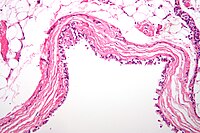
Photo from wikipedia
Objective To analyse the risk of clinical chromosomal abnormalities in foetuses with umbilical cord cysts. Methods Data from all genetic assays that were performed as part of invasive prenatal diagnoses… Click to show full abstract
Objective To analyse the risk of clinical chromosomal abnormalities in foetuses with umbilical cord cysts. Methods Data from all genetic assays that were performed as part of invasive prenatal diagnoses of umbilical cord cysts between October 2014 and June 2021 were retrospectively collected from Guangdong Women and Children Hospital. We compared the differences in genetic assay findings in isolated and nonisolated umbilical cord cyst cohorts. Results A total of 49 singleton pregnancies and 2 foetuses that were one of the cotwins in monochorionic twin pregnancies were enrolled in the cohort; 20 isolated and 31 nonisolated umbilical cord cysts were identified in the cohort. One foetus (5%, 1/20) in the isolated umbilical cord cyst group showed chromosomal abnormalities and 17p12 microduplication. Twelve cases (38.7%, 12/31) of chromosomal abnormalities, including seven cases of trisomy 18, two cases of trisomy 13 and three cases of microdeletion, were identified in the nonisolated umbilical cord cyst group. The incidences of chromosomal abnormalities between the two groups were significantly different (1/20, 5% vs 13/31, 38.7%, p=0.003). There was no relative pathological medical exome sequencing finding in the three foetuses suffering from nonisolated umbilical cord cysts whose parents chose to undergo chromosomal microarray analysis (CMA) and medical exome sequencing. Conclusion This retrospective cohort study evaluated the value of CMA in foetuses with umbilical cord cysts and suggested that copy number variants (CNVs) may be the basic genetic aetiological factors that should be considered for diagnostic evaluation. We recommended CMA as a basic genetic evaluation in cases of umbilical cord cysts, especially in nonisolated cases.
Journal Title: International Journal of General Medicine
Year Published: 2022
Link to full text (if available)
Share on Social Media: Sign Up to like & get
recommendations!